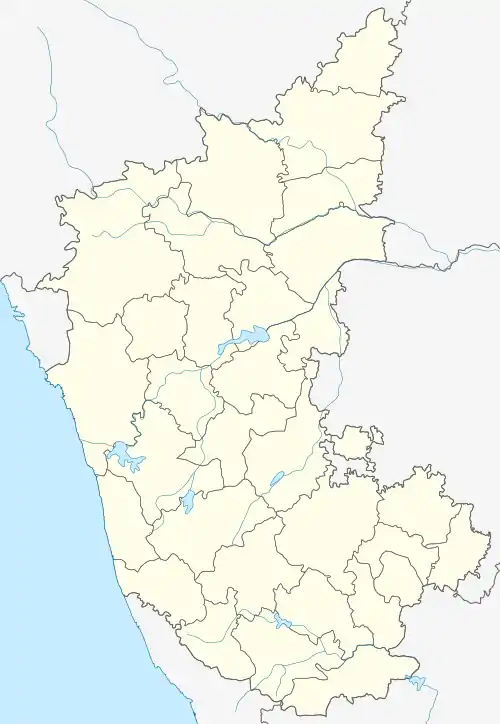Kalale
Kalale is a village in the southern state of Karnataka, India.[1][2] It is located in the Nanjangud taluk of Mysore district.
Kalale | |
|---|---|
village | |
 Kalale Location in Karnataka, India  Kalale Kalale (India) | |
| Coordinates: 12°05′0″N 76°40′0″E | |
| Country | India |
| State | Karnataka |
| District | Mysore |
| Talukas | Nanjangud |
| Government | |
| • Body | Gram panchayat |
| Population (2001) | |
| • Total | 7,278 |
| Languages | |
| • Official | Kannada |
| Time zone | UTC+5:30 (IST) |
| ISO 3166 code | IN-KA |
| Vehicle registration | KA |
| Website | karnataka |
Demographics
As of 2001 India census, Kalale had a population of 7278, with 3636 males and 3642 females.[1]
Pilgrimage centre
Kalale is a well known pilgrimage centre of historical and mythological importance. Kalale is also known as Tulasikanana, Kapilashrama and Venupuri.
According to Sthalapurana, "Janamejaya" the crest jewel of the Pandava dynasty hunting along the course of Kapila and Koundinya Rivers is said to have come across this place of natural enemies cows and tigers living peacefully together and identified the Narayana idol in the bushes of bamboo where this temple was built by him. This idol "Lakshmikantha" is of 3 ft and 6 inches height and divinely beautiful. Kalale in Sanskrit means bamboo. Since the idol was recovered from bamboo bushes, the place is known as Kalale.
Mythology connotes Brahma's worship of this divinely auspicious idol. It is said in puranas that this idol has been worshipped according to the wishes of Maha Vishnu by Athri Mahaamuni the prominent among the Saptharishis.
This place is also known as Kapilashsrama and incident associated with this name is interesting. Kapila Maharshi the son of Kardama having failed to find a peaceful place on the surface of the earth had to finally enter Paathala Loka for his penance. With the passage of time it so happened that the sons of the King Sagara also had to enter Paathala Loka in search of their lost sacrificial horse and found it by the side of Kapila. When they disturbed him with the wrong notion that he has stolen the horse, the curse pronounced by Kapila burnt them to Ashes. Thus prevented in his penance and holding himself responsible for his Thamoguna, Kapila arrived in Dattathreya Muni's Ashrama in Kalale of yore. Puraana state that Kapila was enchanted by the spiritual aura in the proximity of Lakshmikantha and settled here which is the reason why the place was known as Kapilashrama. It is also said that the god manifested here as the son of Athri Maharshi and was known as Dattathreya.
History records Kalale's contribution of famous Dalavais considered to be right hand of Kings. Kalale Dalavais occupied prominent position in both Vijayanagar Empire and the kings of Yadhuvamsha of Mysore. There are documentary evidences to show that Kalale enjoyed some prominence due to its proximity to kings until about 1831. Mysore kings appear to have devoted much attention for improvement of Lakshmikanthaswamy temple. The Mysore king's insignias like Shanka (Conch), Chakra (wheel) and Mathsya (fish) are available in the temple.
The present Lakshmikanthaswamy temple appears to have been built in 3 stages in 1300AD, 1350AD and 1500AD and built in Dravidian style over a wide plot of 100 × 200 ft. The five-storied main Gopuram of the temple is of 50 ft height with 5 Kalashas. The Mahadwara (main gate) is 10 ft wide and 20 ft height. Lakshmikantha, the presiding deity of the temple in Kalale is resplendent with his divine glory in a peacefully bounteous natural environment. The lord here is worshiped according to Pancharathra Agama. The Brahmarathoshva of Lakshmikantha sawmy is held in every year in the month of march or April. This temple is considered as an ancient protected monument by Archaeological Department of Govt. of Karnataka.
See also
- Mysore
- Districts of Karnataka
References
- Village code 2870900."Census of India: Villages with population 5000 & above". Registrar General & Census Commissioner, India. Archived from the original on 11 February 2008. Retrieved 18 December 2008.
- "Yahoomaps India :". Archived from the original on 18 December 2008. Retrieved 18 December 2008. Kalale, Mysore, Karnataka